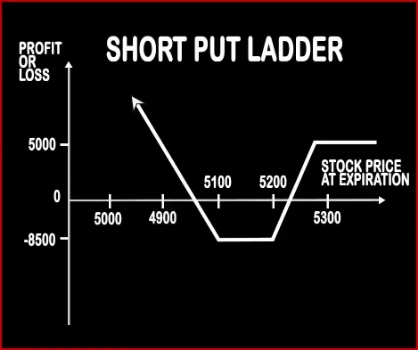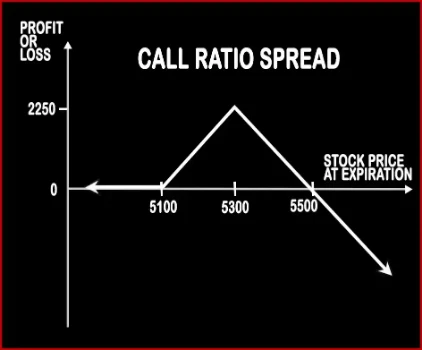Compare Strategies
| SHORT PUT LADDER | RATIO CALL SPREAD | |
|---|---|---|

|

|
|
| About Strategy |
Short Put Ladder Option StrategyThis strategy is implemented when a trader is slightly bearish on the market. A trader is required to be bullish over the volatility in the market. It involves sale of an ITM Put Option and buying of 1 ATM & 1 OTM Put Options. However, the risk associated with this strategy is limited.
|
Ratio Call Spread Option StrategyAs the name suggests, a ratio of 2:1 is followed i.e. buy 1 ITM Call and simultaneously sell OTM Calls double the number of ITM Calls (In this case 2). This strategy is used by trader who is neutral on the market and bearish on the volatility in the near future. Here profits will be capped up to the premium amount and risk will be potentially unlimited since he is .. |
SHORT PUT LADDER Vs RATIO CALL SPREAD - Details
| SHORT PUT LADDER | RATIO CALL SPREAD | |
|---|---|---|
| Market View | Neutral | Neutral |
| Type (CE/PE) | PE (Put Option) | CE (Call Option) |
| Number Of Positions | 3 | 3 |
| Strategy Level | Advance | Beginners |
| Reward Profile | Unlimited | Limited |
| Risk Profile | Limited | Unlimited |
| Breakeven Point | Upper Breakeven Point = Strike Price of Short Put - Net Premium Received Lower Breakeven Point = Total Strike Prices of Long Puts - Strike Price of Short Put + Net Premium Received | Upper Breakeven Point = Strike Price of Short Calls + (Points of Maximum Profit / Number of Uncovered Calls), Lower Breakeven Point = Strike Price of Long Call +/- Net Premium Paid or Received |
SHORT PUT LADDER Vs RATIO CALL SPREAD - When & How to use ?
| SHORT PUT LADDER | RATIO CALL SPREAD | |
|---|---|---|
| Market View | Neutral | Neutral |
| When to use? | This strategy is implemented when a trader is slightly bearish on the market. | This strategy is used by trader who is neutral on the market and bearish on the volatility in the near future. Here profits will be capped up to the premium amount and risk will be potentially unlimited since he is selling two calls. |
| Action | Sell ITM Put Option, Buying 1 ATM & 1 OTM Put Option. | Buy 1 ITM Call, Sell 2 OTM Calls |
| Breakeven Point | Upper Breakeven Point = Strike Price of Short Put - Net Premium Received Lower Breakeven Point = Total Strike Prices of Long Puts - Strike Price of Short Put + Net Premium Received | Upper Breakeven Point = Strike Price of Short Calls + (Points of Maximum Profit / Number of Uncovered Calls), Lower Breakeven Point = Strike Price of Long Call +/- Net Premium Paid or Received |
SHORT PUT LADDER Vs RATIO CALL SPREAD - Risk & Reward
| SHORT PUT LADDER | RATIO CALL SPREAD | |
|---|---|---|
| Maximum Profit Scenario | When Price of Underlying < Total Strike Prices of Long Puts - Strike Price of Short Put + Net Premium Received | Strike Price of Short Call - Strike Price of Long Call + Net Premium Received - Commissions Paid |
| Maximum Loss Scenario | Strike Price of Short Put - Strike Price of Higher Strike Long Put - Net Premium Received + Commissions Paid | Price of Underlying - Strike Price of Short Calls - Max Profit + Commissions Paid |
| Risk | Limited | Unlimited |
| Reward | Unlimited | Limited |
SHORT PUT LADDER Vs RATIO CALL SPREAD - Strategy Pros & Cons
| SHORT PUT LADDER | RATIO CALL SPREAD | |
|---|---|---|
| Similar Strategies | Strap, Strip | Variable Ratio Write |
| Disadvantage | • Best to use when you are confident about movement of market. • Small margin required. | • Unlimited potential loss. • Complex strategy with limited profit. |
| Advantages | • When there is surge in implied volatility, this strategy can give more profit. • Unlimited downside profit. • Limited risk and unlimited reward strategy. | • Downside risk is almost zero. • Investors can book profit from share prices moving within given limits. • Trader can maximise profit when the share closes at the upper breakeven point. |